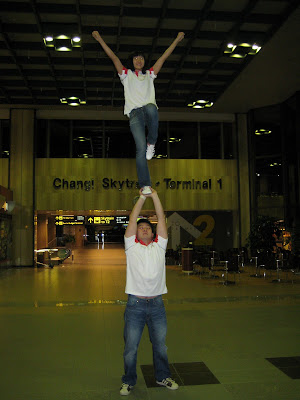Below is abstract from
http://gymnastics.about.com. The author is Nancy Thies Marshall, also a ex-gymnast. I found the article quite useful and would like to share with everyone.
1. Gymnastics is a multifaceted sport.This is a sport that develops physical strength, speed, agility, nerves of steel, and competitive prowess. Additionally, women must wrap that package of athleticism in grace and personality. Not many sports draw upon such a wide range of ability. Within the three main gymnastics disciplines (Men's and Women's Artistic and Rhythmic), there are as many as 15 different individual events, each with unique challenges and thrills. Add General Gymnastics and Trampoline and Tumbling, and opportunities in the sport are endless.
2. Gymnastics is a challenging sport.Walking, let alone flipping, is hard to do on a four-inch balance beam. It takes more than a few push-ups to master an iron cross on the rings. Leaping through a moving hoop is not a cake walk. Gymnastics is "difficult." But the very qualities it takes to master these skills - courage, perseverance, risk, determination, vision - are the qualities that foster excellence in any endeavor. Dealing with the "difficulties" will translate into valuable life skills and strength of character. Bolstered by unconditional love from parents and skilled guidance from coaches, gymnasts are better prepared to handle the "difficulties" of life because of the challenges faced in the gym.
3. Gymnastics is a socially interactive sport.The unique social environment in the gym provides for healthy growth. In gymnastics, a nine-year old trains with older and younger athletes. Self-esteem is boosted by camaraderie with older teammates. Maturity and perspective is nurtured as she then turns to relate to the younger athletes on the team. Few sports provide the opportunity for kids to work so closely with teammates of different ages. The social maturity gained within the sport is far healthier than the "social immaturity" forced on kids spending aimless afternoons at the mall or watching television.
4. Gymnastics teaches individual responsibility and courage.Though there is a team element, gymnastics is an individual sport. When practice is over and the green flag is raised, the athlete faces the apparatus alone. To execute a routine successfully, under the scrutiny of judges, coaches and spectators, it takes concentration, determination, endurance, and often courage. Confidence to call upon these qualities is nurtured every time a child attempts another routine. Life requires us to take personal responsibility for the choices we make. Courage to take that responsibility and make right choices is developed with each mount and dismount.
5. Gymnastics enriches childhood.After my Olympic experience, I was often asked if I felt like I had sacrificed a normal childhood for my athletic dreams. I was always a bit confused by this question. I did gymnastics because I wanted to. Sports was not a sacrifice, it was a choice. Granted, that choice meant sometimes I was also choosing to forego other activities. But thanks to guidance from my parents and coaches, gymnastics opened doors and enriched my life. Victories, defeats, travel, relationships and much more combined to teach me the joys, difficulties and realities of our world.
And I'm not alone. Traveling the country to develop the Athlete Wellness Program for USA Gymnastics, I've had the privilege of meeting former gymnasts who now have careers in counseling, medicine, advertising, law, youth ministry, coaching, emergency response, environmental engineering and parenting, to name a few. All agree their gymnastics training better prepared them to tackle the challenges of the adult world.
It takes wise coaches and parents to translate gym lessons into life lessons. But most gymnastics clubs are founded on the belief that the sport has the potential to be a health-enhancing experience for all who participate. If anyone is looking for fertile soil in which to grow life's champions, you might start at your local gymnastics club.
Nancy Thies Marshall is a 1972 Olympian, five-time national team member, former national Vault and Balance Beam champion, and collegiate All-American. She is currently the developer and manager of USA Gymnastics Athlete Wellness Program and a freelance journalist. Nancy and her husband have three children and live in Salem, Oregon.



























































